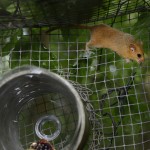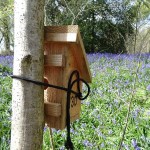Dormouse reintroductions
Make your donationDormouse reintroductions are a really important part of our conservation programme as they help boost local populations where dormice are present, or put them back on the map in areas where they have been lost. Locations are chosen carefully, taking into account the suitability of the woodland and potential connections to other woodland areas.
Before the day of the release, captive bred dormice are quarantined and  then health checked before they are paired up and safely put into dormouse houses, ready for their journey to a top-secret woodland. The location is kept secret so the dormice aren’t disturbed.
then health checked before they are paired up and safely put into dormouse houses, ready for their journey to a top-secret woodland. The location is kept secret so the dormice aren’t disturbed.
Large cages are secured to trees, and the dormouse houses placed inside. The dormice are then free to roam in their large cages for the next couple of weeks until they have acclimatised to their new home. Volunteers check the cages and provide food and water. After two weeks the cages are opened allowing the dormice to go free and explore their new surroundings.
 More dormouse houses are placed in the surrounding woodland to give the dormice somewhere to nest over the summer and autumn. It also allows us to monitor the new population to see if they breed.
More dormouse houses are placed in the surrounding woodland to give the dormice somewhere to nest over the summer and autumn. It also allows us to monitor the new population to see if they breed.
Long-term, we make sure the woodland is managed in a way that benefits the dormice and help improve the connections to nearby woodlands. This means that the dormice can meet breeding partners from other populations, ensuring a healthy new generation of dormice.
By housing a dormouse, you’ll help support future dormouse reintroductions, provide dormice a safe home and allow us to monitor how they are doing year on year.
House a dormouse

